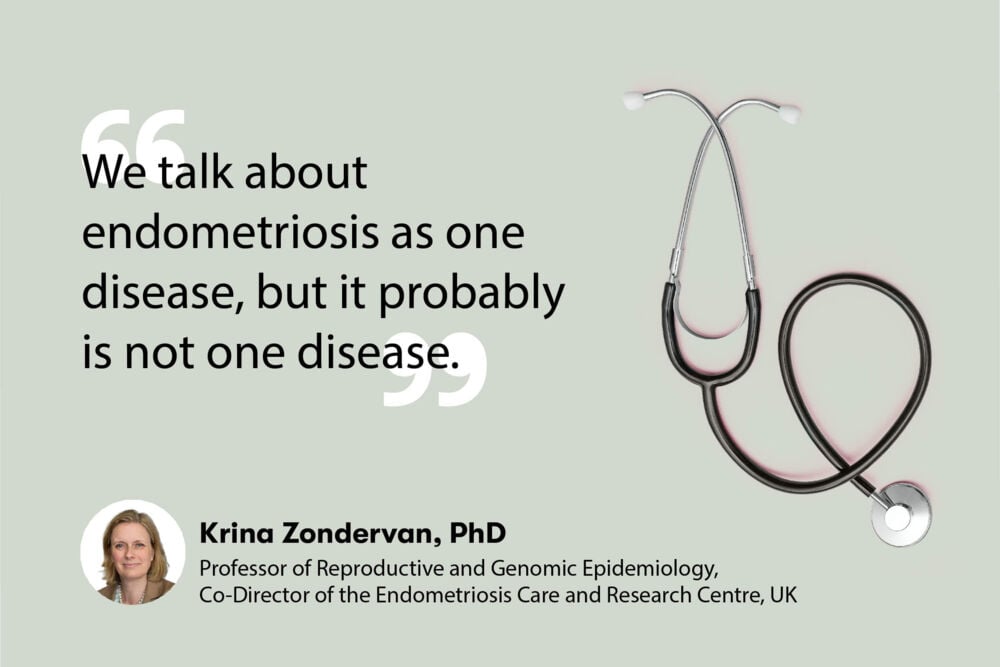What are the challenges of diagnosing and treating endometriosis that researchers are still grappling with? Dr. Krina Zondervan, professor of reproductive and genomic epidemiology, answers.
-
Tracking cycle
-
Getting pregnant
-
Pregnancy
-
Help Center
-
Flo for Partners
-
Anonymous Mode
-
Flo app reviews
-
Flo Premium New
-
Secret Chats New
-
Symptom Checker New
-
Your cycle
-
Health 360°
-
Getting pregnant
-
Pregnancy
-
Being a mom
-
LGBTQ+
-
Quizzes
-
Ovulation calculator
-
hCG calculator
-
Pregnancy test calculator
-
Menstrual cycle calculator
-
Period calculator
-
Implantation calculator
-
Pregnancy weeks to months calculator
-
Pregnancy due date calculator
-
IVF and FET due date calculator
-
Due date calculator by ultrasound
-
Medical Affairs
-
Science & Research
-
Pass It On Project New
-
Privacy Portal
-
Press Center
-
Flo Accuracy
-
Careers
-
Contact Us
Endometriosis Diagnosis and Treatment Challenges


Every piece of content at Flo Health adheres to the highest editorial standards for language, style, and medical accuracy. To learn what we do to deliver the best health and lifestyle insights to you, check out our content review principles.
Interview has been edited for clarity.
How endometriosis is diagnosed
In terms of diagnosis, the gold standard remains being able to visualize the disease, according to Dr. Zondervan. That requires surgery, typically through laparoscopy, which involves inserting an endoscope into the abdomen so that a clinician can have a look around and see whether you have endometriosis.
“If you do, they are able to remove that disease. That’s quite a skilled job, so it’s important to make sure the person treating is experienced in treating endometriosis.”
She says that if you have a large cyst on your ovaries, or if you have a large endometriosis nodule, then that can typically be detected with an ultrasound or MRI (magnetic resonance imaging). Generally, clinicians are pretty good at diagnosing that type of disease through imaging.
“But if you have a more superficial peritoneal disease, it won’t be picked up through any imaging technique. You would need to have surgery for diagnosis. That is a challenge,” Dr. Zondervan explains.
“Ideally, we would like to be able to use a blood test or urine test to detect endometriosis. And that is what a lot of groups worldwide are working on. So far, there isn’t a test out there that is reliable.”
Endometriosis treatment
Dr. Zondervan says that when it comes to endometriosis treatment, a skilled surgeon should be able to at least remove some or most of the endometriosis. “That does not guarantee a cure; sometimes it comes back. And that’s on a case-by-case basis,” she explains.
“And the other main treatment is medication — typically hormonal treatment. Hormonal treatment is not always ideal, and it is not for everyone. It does not always treat all the symptoms effectively. So usually, it is a bit of trial and error.”
Dr. Zondervan says you might be prescribed oral contraceptives to see to what extent they help reduce symptoms, or progesterone subsequently. And there are stronger hormonal medicines that really shut down the hormonal system, but typically you cannot use them for a very long time for a number of reasons. They tend to be more temporary solutions. Treatment is something that a lot of researchers and clinicians are trying to improve.
“People with endometriosis would like something non-hormonal, but at the moment there is nothing out there on the market that does that job,” says Dr. Zondervan.
Can endometriosis go away on its own?
Dr. Zondervan says that whether endometriosis can go away by itself is not known.
“We do not know because the only way we can really track the disease is to do repeated surgeries to see how the disease progresses. And that’s something that really you would not want to do because it is not without complications. Every time you do surgery, it may cause some damage. And you don’t want to do that repeatedly just to be able to observe the disease. People do have repeated laparoscopies, but typically that is because their symptoms return, and they need a new evaluation.”
Take a quiz
Find out what you can do with our Health Assistant

She says that there are older studies that investigated to what extent endometriosis progresses based on repeated laparoscopies. And the data show this fluctuates: for some, surgery is effective, and endometriosis doesn’t return; for others, surgery is less effective, and it does come back.
“And again, we think that this is probably due to the fact that we talk about endometriosis as one disease, but it probably is not one disease.”
Dr. Zondervan says it’s important to stress that endometriosis is not cancer, but the way scientists now think about cancer — cancer is no longer one disease — is perhaps how we should think about endometriosis.
“If, for example, a person is diagnosed with breast cancer, typically people look at the tumor, and they profile it in a certain way, and they know that if a person has one profile, they would benefit from one type of treatment; if they have another profile, they would benefit from something else. And it is recognized there are different subtypes, different forms of disease. So we think that with endometriosis, this is probably the same. A person might have a less progressive type, where a single surgery might cure them, or they might have a more progressive type.”
Dr. Zondervan says that understanding what those subtypes are is exactly what researchers are looking into now. They are trying to identify these subtypes to be able to design better-targeted treatments for endometriosis.


Hey, I'm Anique
I started using Flo app to track my period and ovulation because we wanted to have a baby.


The Flo app helped me learn about my body and spot ovulation signs during our conception journey.


I vividly
remember the day
that we switched
Flo into
Pregnancy Mode — it was
such a special
moment.
Real stories, real results
Learn how the Flo app became an amazing cheerleader for us on our conception journey.




